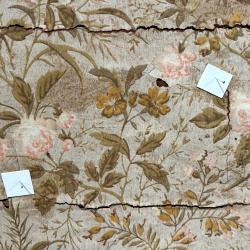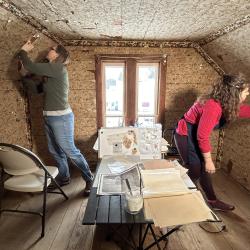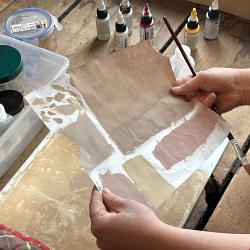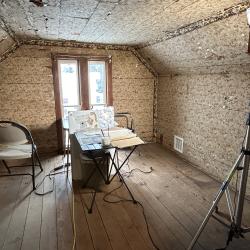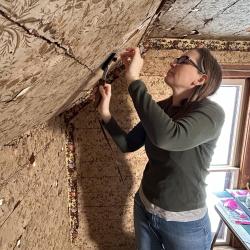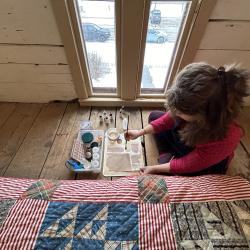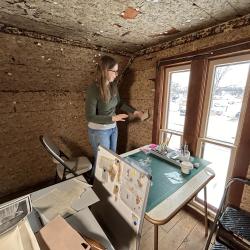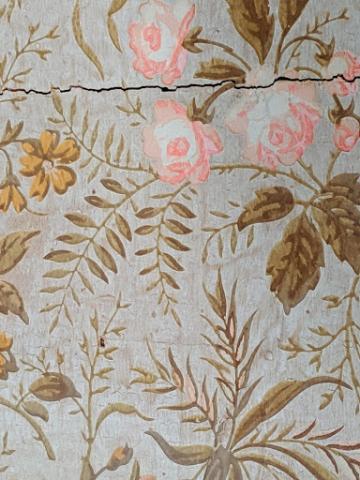
Conservation of Willa Cather's Attic Bedroom Wallpaper
As part of the 2019 collections and buildings transfer between History Nebraska and the Willa Cather Foundation, the Gerald R. Ford Conservation Center provided expert technical assistance to plan for the wallpaper conservation in the author’s attic bedroom at the Willa Cather Childhood Home. Long after Cather left Red Cloud and became a Pulitzer Prize-winning author, she still fondly recalled the tiny attic bedroom she occupied as a child. Writing to her brother Roscoe from Maine in 1945, Cather mused:
"I have a funny little room in the attic here, with a sloping ceiling, like my 'rose bower' in our old first house. Do you remember? I can always work best in a low room under the roof."
One of twenty-one National Historic Landmarks in Nebraska, the Willa Cather Childhood Home was designated in 1972 after its purchase and restoration by the Willa Cather Foundation in 1960. It can be visited by guided tour from the National Willa Cather Center. Built around 1879, the house was rented by the Cather family from 1884-1904. Young Willa, the eldest of seven who was given her own bedroom, lived there with her family from the age of ten until she left for college in 1890 at the age of sixteen. She returned for regular visits until she moved to Pittsburgh in 1896 and less frequently to Red Cloud after that.
For many of our guests, seeing Willa Cather’s attic bedroom, still adorned in its original paper with pink roses, is the highlight of their visit to Red Cloud. Unfortunately, decades of light damage and environmental instability have taken a toll on the wallpaper. Cather acquired the rose-strewn wallpaper while employed at Dr. Cook's drugstore. She would later write the bedroom description, and a papering experience, into The Song of the Lark (1915) when describing the young Thea Kronborg’s bedroom:
"The ceiling was so low that a grown person could reach it with the palm of the hand, and it sloped down on either side. There was only one window, but it was a double one and went to the floor. In October, while the days were still warm, Thea and Tillie papered the room, walls and ceiling in the same paper, small red and brown roses on a yellowish ground."
In May 2019, we were thrilled to launch a preliminary conservation treatment of Cather's beloved wallpaper. Paper conservator Hilary LeFevere and conservation technician Megan Griffiths from the Gerald R. Ford Conservation Center at History Nebraska were on-site for four days to begin the process and evaluate the original wallpaper (c.130 years old). They cleaned the paper on the walls and stabilized as many loose areas as possible. This tedious work was fascinating to watch as accumulated dust and oils were removed inch by inch, brightening the circa 1888 paper. While cleaning, the team was able to locate a manufacturer.
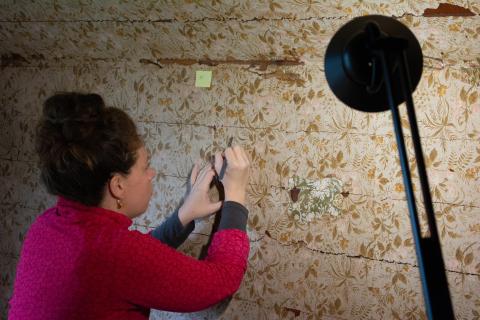
With support from a Save America's Treasures grant, testing to stabilize the wallpaper was performed by LeFevere in June 2022. The primary objective of the wallpaper conservation and treatment project has been to find a balance between stabilizing the losses in the paper while improving the overall appearance for the historic space. Further testing helped to determine the safest and most efficient and best methods of on-site stabilization and the most stable and functional conservation-grade materials to utilize. This work also enabled us to compare visual examples of various stabilization techniques.
The recent restoration and rehabilitation of the Willa Cather Childhood Home has provided a stable environment for the next phase of the conservation effort. The addition of a vapor barrier a climate control system in the attic system ensures environmental conditions will that will aid in preserving the wallpaper and will allow for further conservation treatments to be carried out effectively.
Beginning the week of March 4, 2024, the wallpaper surface will be thoroughly cleaned again as the conservation and treatment process resumes. Conservators will then adhere detached pieces of wallpaper using Japanese paper fills and conservation-grade adhesives. Wallpaper losses that are at least 1/4" in diameter will be filled with an acrylic-toned paper fill.
While we will be unable to restore the wallpaper to its original appearance, the conservation and treatment efforts will slow the deterioration, improve the overall appearance of the paper, and extend its lifespan. The discovery of the wallpaper's manufacturer will make it possible to further explore options to recreate the paper in an effort to make viewing the wallpaper selected by Cather more accessible to all visitors for generations to come.
As with the places associated with famous authors, Willa Cather's bedroom has become a literary shrine for visitors and her original wallpaper is an essential part of that experience. Cather created her space well ahead of the concept of "A Room of One's Own" as Virginia Woolf would recommend for women writers in her 1929 essay. It was also the kind of attic bedroom, with its sloping matchboard ceiling, that Cather requested when later staying and writing from the Shattuck Inn in Jaffrey and the study of her cottage at Grand Manan. Remarkably preserved here in rural Red Cloud is a simple attic bedroom which, for a few pivotal years in a small and busy household of nine, provided the eldest child the solitary space needed for her young mind to imagine a much bigger world.
If you would like to support our ongoing wallpaper conservation efforts, please contact development coordinator Ashley Olson at aolson@willacather.org or (402) 746-2653. You may also donate here or shop our exclusive line of Willa's wallpaper products.
For more information:
- "Restoring Willa Cather's Attic Bedroom Wallpaper," History Nebraska Blog, May 9, 2019
- "History Nebraska Transfers Willa Cather State Historic Site to the Willa Cather Foundation," History Nebraska Blog, January 23, 2019
- "Flowers in the Attic," History Nebraska Blog, June 19, 2019
- "Cather Wallpaper Preservation Project," Pure Nebraska video segment with Jon Vanderford, May 9, 2019
- "Save America's Treasures Grant Awarded for Restoration of Willa Cather's Childhood Home," September 26, 2019
- "Restored Willa Cather Childhood Home Reopens," December 5, 2023

